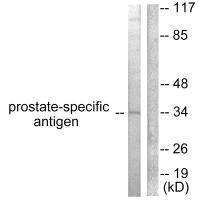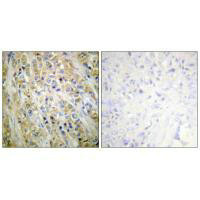KLK3 Antibody
-
货号:CSB-PA697334
-
规格:¥2024
-
图片:
-
其他:
产品详情
-
产品名称:Rabbit anti-Homo sapiens (Human) KLK3 Polyclonal antibody
-
Uniprot No.:P07288
-
基因名:KLK3
-
宿主:Rabbit
-
反应种属:Human,Mouse
-
免疫原:Synthesized peptide derived from Human prostate-specific Antigen.
-
免疫原种属:Homo sapiens (Human)
-
克隆类型:Polyclonal
-
纯化方式:The antibody was affinity-purified from rabbit antiserum by affinity-chromatography using epitope-specific immunogen.
-
浓度:It differs from different batches. Please contact us to confirm it.
-
产品提供形式:Liquid
-
应用范围:ELISA,WB,IHC
-
推荐稀释比:
Application Recommended Dilution WB 1:500-1:3000 IHC 1:50-1:100 -
Protocols:
-
储存条件:Upon receipt, store at -20°C or -80°C. Avoid repeated freeze.
-
货期:Basically, we can dispatch the products out in 1-3 working days after receiving your orders. Delivery time maybe differs from different purchasing way or location, please kindly consult your local distributors for specific delivery time.
相关产品
靶点详情
-
功能:Hydrolyzes semenogelin-1 thus leading to the liquefaction of the seminal coagulum.
-
基因功能参考文献:
- Genome-wide association study of prostate-specific antigen levels identifies novel loci independent of prostate cancer. PMID: 28139693
- Men with mild to no lower urinary tract symptoms (LUTS) but increased baseline PSA are at increased risk of developing incident LUTS presumed due to benign prostatic hyperplasia PMID: 29795141
- PSA-density might inform biopsy decisions, and spare some men from the morbidity associated with a prostate biopsy and diagnosis of low-grade prostate cancer. PMID: 29259293
- Differences in fPSA-recovery between all investigated assays were even more pronounced. When applying the tPSA cutoff of 3.1 mug/L recommended for WHO-calibrated assays, the use of higher calibrated assays may lead to unnecessary prostate biopsies. Conversely, if the historical threshold of 4 mug/L is applied when using WHO-calibrated assays, it could lead to falsely omitted prostate biopsies. PMID: 29734838
- PSA was the only independent predictor of extensive lymph node invasion and could be an important preoperative factor for stratifying high-risk patients. PMID: 29714659
- ue to the biocompatibility, multivalency, stability, and high structural homogeneity, the t-PSA-specific landscape phage demonstrates as a novel specific interface in biosensors. PMID: 29414091
- Based on the target-induced catalytic hairpin assembly and bimetallic catalyst, the enzyme-free recycling amplification strategy for sensitive detection of prostate specific antigen (PSA) has been designed PMID: 29156407
- The prepared biosensor can assay from 0 to 500ng/mL of prostate specific antigen (PSA) level within 2h with the detection limit of 1.18ng/mL by the measurement of resistance change. The resistance change was caused by site selective interaction between PSA and PSA-antigen with an inexpensive bench top digital multimeter (5 1/2 digits) PMID: 29172142
- he superwettable f-PSA microchip can accurately detect human serum samples with excellent correlations with chemiluminescence immunoassay in the clinic, demonstrating its great potential as a sensitive and reliable sensing platform for biological analysis and clinical diagnosis. PMID: 29175217
- The 12-week PSA response rate was 88% (22/25) and 22% (4/18), median time to PSA progression was 18.2 months [95% confidence interval (CI), 8.3 months-not reached) and 3.7 months (95% CI, 2.8-5.6 months), and median time on treatment 21 months (range, 2.6-37.5) and 4.9 months (range, 1.3-23.2), for the AAP-naive and post-AAP cohorts, respectively. PMID: 28213364
- The results support that u-PSA provides useful information for predicting predicting biochemical recurrence after radical prostatectomy . This can be beneficial to avoid unnecessary adjuvant treatments or to start them earlier for selected patients PMID: 27805011
- this meta-analysis suggests that PSA -158G/A polymorphism may be a protecting factor against BPH in Caucasian populations, but it may enhance the disease risk in Asians. PMID: 28430620
- Developed risk assessment models for North Chinese patients with 4-50 ng/mL PSA to reduce unnecessary prostate biopsies and increase the detection rate of prostate cancer. PMID: 28039477
- Data show positive associations of relative Gal-3 and relative PSA levels in prostate cancer patients, notably at early clinical time course. PMID: 27741512
- Both the extent of comorbidity and the PSA doubling time should be taken into consideration when deciding on appropriate management and/or clinical trial eligibility at the time of PSA failure. PMID: 28117382
- As restaging in advanced prostate cancer patients is often guided by increases in PSA levels, our results demonstrate that disease progression on enzalutamide can occur without rising PSA levels. Therefore, a disease monitoring strategy that includes imaging not entirely reliant on serial serum PSA measurement may more accurately identify disease progression. PMID: 28117385
- Older men who underwent no PSA testing or incomplete testing were significantly more likely to be diagnosed with high-risk prostate cancer than those who were previously screened. It is reasonable to consider screening in healthy older men likely to benefit from early detection and treatment. PMID: 28045113
- end-of-radiation PSA was significantly associated with survival endpoints in men who received treatment with definitive radiation and ADT. Whether the EOR PSA can be used to modulate treatment intensity merits further investigation. PMID: 28094250
- the concentrations of insulin, IGF-1, IGFBP-3 and their association with prostate size in patients with BPH PMID: 28300542
- Data suggest that occurrence of PSA failure was associated with increased risk of all-cause mortality (ACM) only in men with no or minimal, but not moderate-to-severe, comorbidity. PMID: 27601545
- Microenvironmental acidity determines qualitatively and quantitatively the release of extracellular vesicles by malignant prostate tumors. This leads to the spill-over of nanovesicles into the peripheral blood of prostate cancer patients, where the levels of tumor biomarkers expressed by exosomes, such as PSA-exosomes, may represent a novel, non-invasive diagnostic tool. PMID: 28694142
- Promoter methylation of MCAM, ERalpha and ERbeta have a potential to be utilized as biomarker for the early detection of prostate cancer (PC) as their sensitivity and specificity seem to be better than serum PSA. PMID: 28147335
- Data suggest no influence of chronic periodontitis treatment on PSA levels in asymptomatic men. PMID: 28551659
- Circulating total PSA levels were strongly associated to leukocyte telomere length in a national sample of men without prostate cancer. PMID: 27566127
- I might also point out that whether a particular surgical procedure did more good than harm at that time was highly dependent on whether it was conducted with good sterile procedure. PSA screening is a contemporary example of this historical lesson PMID: 27010733
- Data show that forkhead box M1 protein (FOXM1) directly binds to the FHK binding motifs in the prostate specific antigen (PSA) promoter/enhancer regions. PMID: 28199985
- Study suggests that the prognostic value of PSA declines in heavily treated patients receiving enzalutamide PMID: 28614217
- novel urinary gene expression signature that may be the least invasive of available options by not requiring a digital rectal examination or phlebotomy as a reflex test in men for whom PSA testing raises the suspicion of prostate cancer PMID: 27031887
- For PSA screening to be cost-effective, it needs to be used conservatively and ideally in combination with a conservative management approach for low-risk disease PMID: 27010943
- Both the incidence of early-stage prostate cancer and rates of PSA screening have declined and coincide with 2012 USPSTF recommendation to omit PSA screening from routine primary care for men. Longer follow-up is needed to see whether these decreases are associated with trends in mortality. PMID: 27010657
- Distinctive immunohistochemical expression of PAX8 and lack of prostate-specific antigen can help in distinguishing this benign entity from prostatic adenocarcinoma. PMID: 21606823
- Circulating prostate-derived PSA and membrane PSM mRNA pre- and post-radical prostatectomy improves accuracy of a nomogram to predict biochemical recurrence of prostate cancer. PMID: 22228175
- Purified PSA cleaves complement factor iC3b in a previously uncharacterized function of PSA as an immunoregulatory serine protease that can help create an environment hospitable to malignancy through proteolysis of the complement system. PMID: 23401592
- Extended follow-up of the PLCO trial over a median of 15 years continues to indicate no reduction in prostate cancer mortality for the intervention arm versus the control arm. Because of the high rate of control-arm PSA testing, this finding can be viewed as showing no benefit of organized screening versus opportunistic screening PMID: 27911486
- Data indicate that prostate specific antigen (PSA) is a negative predictive biomarker for local recurrence during follow-up. PMID: 27834929
- TC genotype of rs1058205 lower in prostate cancer group than in control group; TT genotype associated with prostate cancer PMID: 28272245
- The prostate-specific antigen density (PSAD) cutoff level generated for Nigerian men in this study is 0.04 which is relatively different from international consensus. This PSAD cutoff level has a positive correlation with histology and could detect patients with prostate cancer who have "grey zone PSA." PMID: 27356753
- The combined efficacies of whole-body magnetic resonance imaging, bone scintigraphy and PSA levels were desired in identifying prostate cancer lesions and prognosis. PMID: 27941343
- A combination of high preoperative serum PSA and high expression of TMPRSS2-ERG could be promising in distinguishing those tumors that are aggressive and life-threatening. PMID: 27630329
- Higher miR-139-5p expression in prostate cancer patients was observed to be associated with certain clinicopathological parameters, including PSA greater than 20ng/ml, pathological tumor stage, and Gleason score. PMID: 27562849
- PSA velocity can be more predictive after surgery and PSA doubling time can be more predictive after radiation therapy. PMID: 26767890
- Prostate health index achieved the best predictive performance for detecting prostate cancer and was not influenced by body mass index. PMID: 26754552
- Salvage radiotherapy conferred better prostate cancer control when administered at the very first sign of PSA rise. PMID: 26497924
- Studies indicate that the prostate health index (phi) is a biomarker panel that includes free prostate-specific antigen (PSA), total PSA, and [-2]proPSA. PMID: 27023445
- PSCA TT genotype is associated with a more than a threefold increase in the prevalence and the extent of gastric mucosal intestinal mucosa compared to C allele carriers among H. pylori-infected Bhutanese. PMID: 26706772
- Prostate magnetic resonance imaging before prostate biopsy appeared to offer similar diagnostic accuracy compared with routine transrectal ultrasound-guided random biopsy in the diagnosis of suspected prostate cancer based on elevated prostate specific antigen values. PMID: 26033153
- We observed an association of higher Ki-67 expression with Gleason sum National Comprehensive Cancer Network risk (P=0.013) and PSA recurrence PMID: 26458958
- Results show that urinary PSA glycoforms are able to discriminate prostate cancer from protastatic hyperplasia with higher sensitivity and specificity for prostate cancer than those of the serum PSA marker. PMID: 27065039
- No significant differences in in KLK3 expression were found between radical prostatectomy-prostate cancer and radical prostatectomy-benign samples. PMID: 26928323
- BMI should be taken into consideration when referring men to a prostate biopsy based on serum PSA-levels. PMID: 26914149
显示更多
收起更多
-
亚细胞定位:Secreted.
-
蛋白家族:Peptidase S1 family, Kallikrein subfamily
-
数据库链接:
HGNC: 6364
OMIM: 176820
KEGG: hsa:354
STRING: 9606.ENSP00000314151
UniGene: Hs.171995
Most popular with customers
-
Phospho-YAP1 (S127) Recombinant Monoclonal Antibody
Applications: ELISA, WB, IHC
Species Reactivity: Human
-
-
-
-
-
-
-






















